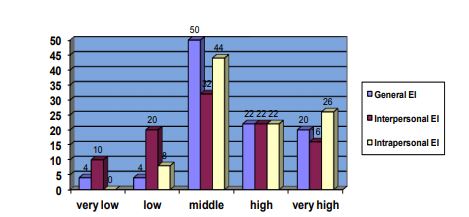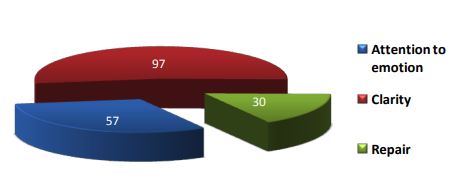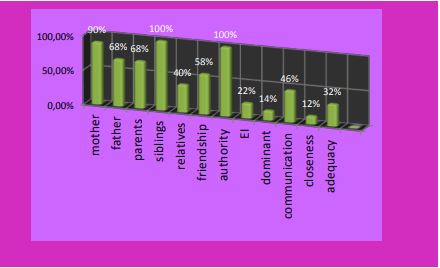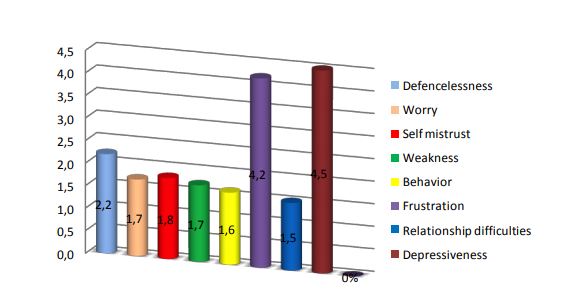Abstract
Good parenting requires more than intellect and touches a dimension of personality that's been ignored over the past years. It involves emotion and emotional intelligence which has great consequences The research question involves an issue of Emotional intelligence as educational resourse for parents, and whether it has an impact to Emotional intelligence of their children Analyze the emotional intelligence in family relations and show the impact of emotional intelligence on personality of the child. Research methods were used as follows: 1) EmIn questionnaire for emotional intelligence of Lusin D.V. 2) TMMS (the Trait Meta Mood Scale) for emotional intelligence 3) Rene Gille test for children emotional state 4) Picture test measuring personality of children 1) High level of emotional intelligence (EI) of parents positively correlates with the EI of the children. 2) Interpersonal EI and intra personal EI of parents are significantly connected with high emotionality of the child. 3) Attention to emotions and Clarity of the parents positively correlates with the EI of the children. The EI level of the parents can be a predictor of emotional intelligence development in children. The understanding of the emotions and ability to control them is an important and necessary component in social life of the personality. And also these abilities play an important role in development of a self-assessment, empathy, self-controlling of the growing-up child.
Keywords: Emotional intelligence, Parents and children relationships
1.Introduction
Good parenting requires more than intellect. It touches a dimension of the personality that's been ignored in much of the advice dispensed to parents over the past thirty years. Good parenting involves emotion. In the last decade or so, science has discovered a tremendous amount about the role emotions play in our lives. Researchers have found that even more than IQ, your emotional awareness and ability to handle feelings will determine your success and happiness in all walks of life, including family relationships. For parents, the quality of "emotional intelligence” (EI) - means being aware of your children's feelings, and being able to empathize, soothe, and guide them. For children, who learn most lessons about emotion from their parents, it includes the ability to control impulses, delay gratification, motivate themselves, read other people's social cues, and cope with life's stressful situations.
1.1 Background of EI
Emotional intelligence issue is investigated since 90s in modern psychology. "Family life is our first school for emotional learning" writes Goleman (1995), psychologist and author of Emotional Intelligence. The emotional schooling operates not just through the things parents say and do directly to children, but also in the models they offer for handling their own feelings and those that pass between husband and wife. Some parents are gifted emotional teachers, others atrocious. According to the latest researches children whose parents consistently practice Emotional Intelligence in their life have better physical health and score higher academically than children whose parents don't offer such guidance. These children get along better with friends, have fewer behavior problems, and are less prone to acts of violence. Over all, children who are emotionally trained experience fewer negative feelings and more positive feelings. In short, they're more healthy emotionally.
What are the core components of high EQ? Emotional self knowledge and self acceptance, sensitivity to the cues of others, empathy (which can be defined as the ability to see and feel something from the other’s point of view), and the ability to regulate one’s own anxiety in order to talk about emotionally charged issues in a constructive way.
It is necessary to note, that there are various models and definitions of emotional intelligence. The term «Emotional intelligence» was first used by Leuner (1966). Since then the set of EI definitions and ways of measurements which can be grouped in following models were offered.
Models of abilities which understand and define EI as a set of abilities measured by means of tests. The founders of the given model are Mayer and Salovey (Matthews, 2002). They approve,
that EI is an ability to perceive emotions, to understand and generate emotions, to define a degree of perception and understanding of emotions, to operate by emotional knowledge for the reflectual regulation, promoting intellectual development. The given model has been put in foundation of Mayer-Salovey-Caruso Emotional Intelligence Test created by them (MSEIT) (Mayer, 2005). This test includes 4 "branches", each of which is divided into 2 subtests. The test helps to reveal a quantitative equivalent of such parameters as identification of emotions, increase of efficiency of thinking, understanding of emotions, and management of emotions.
According to Mayer (2005), prominent aspect of EI is ability to understand the emotions and to operate them. So, Mayer et al. presented the idea that people understand emotions by means of their monitoring, estimation and regulation. They designated this process as Meta-mood experience and developed so-called State Meta-Mood scale which measures constant changes of mood of a person. For measurement of more stable individual differences and for analysis of emotional changes of mood, Salovey et al. (1995) created questionnaire The Trait Meta-Mood Scale (TMMS), consisting of such scales, as: Attention to emotions, Clarity and Repair (Salovey, 2002).
Also there are a number of authors exploiting the given model. For example, Ekman (1999) whose concept states that EI is based on various emotions did it. He distinguished these emotions from each other by means of the description of their characteristics, and found differences between emotions and mood.
The model considering EI as the individual characteristic of a person, offered by Pertrides and Furnham (2000), also has given a push to several researches in the field of confirming the given assumption. The research carried by Schutte et al. (1998) who approve the idea about investigation of general EI provides research of four EI sub-factors which are simultaneously similar and at the same time not comparable among themselves: perception of emotions, use of emotions, management of relevant emotions, and management of emotions of other people. The given factors further were included in TMMS created by above mentioned authors (Schutte Self-Report Inventory, SSRI).
The mixed models were basically developed in models of emotional competence by Goleman (1995), and models of emotional-social intelligence R. Bar-On (1995, 1997) considered that emotional and social intelligence are multifactor set of interacted emotional, personal and social abilities which influence our ability actively and effectively to cope with daily difficulties. He has developed and used in the research his test - Bar-On Emotional Quotient Inventory (EQ-i), consisting of 132 items for definition of 15 factors incorporated in the general structure: intrapersonal EI, interpersonal EI, adaptations, management of stress, the general mood (Bar-On, 1997).
Popularity of the this model and EI in general increased with the publication of bestseller “Emotional intelligence” by Goleman in 1995 in «Time magazine». He considers emotional intelligence as ability to be self motivated and resistible to frustrations, to supervise impulses, to be able to master one’s own mood and to be sensible in distress situations.
The idea of unity of affect and intelligence is presented as a result of important research of internal psychologists like Vigotsky, Rubinstein, 1973; Leontev, (1975); Luriya, (1982); Zejgarnik, Tikhomirov, (1984); Jakupov.
In the works of these classic representatives of psychological science, Rubinstein (1973), Leontev (1975), Tikhomirov (1984) and others is given a profound analysis of mechanisms and
processes of emotions. Leontev (1975) stated the necessity to distinguish conscious objective value and its importance for the subject (Personal sense). The sense creates partiality of human consciousness (Leontev, 1975). Rubinstein (1973) whose opinion of emotion or affectivity as the only one, specific part of processes which actually are at the same time the cognitive processes reflecting the validity supported the abovementioned idea. Emotional processes, thus, cannot be opposed to cognitive processes as external, each other excluding counterparts (Rubinstein, 1973).
Works of the internal founder of neuropsychological science Luriya (1982) who brought certain contribution to development of ideas about interrelation of neurophysiologic, affective and cognitive processes are described further. And also works of Tikhomirov (1984) who with colleagues, has published the collective monography where the issue of emotional regulation of cognitive activity is investigated. He has made an attempt to consider a parity of cognitive and emotional processes in accordance with psychological systematic analysis. He emphasized the role of emotional processes in purpose development and sense development Lyusin (2004) considers EI as some structure, which has the dual nature and connected, on the one hand, with cognitive abilities, and on the other hand - with personal characteristics. Functional features of emotions have been in details considered by Vilyunas (1984) in the work «the Basic problems of the psychological theory of emotions» and which are presented in this work. In his opinion, full discharge of emotions from function of inducement makes senseless and function of estimation produced by them as well.
Such theories of emotions, as the theory of James Lange who was one of the first who tried to connect emotions and vegetative shifts in organism of a person, which accompany emotional experiences. The theory assumes, that after perception of the event which has caused the emotion, the person experiences this emotion as sensation of physiological changes in his own organism, i.e. physical sensations are emotion.
According to the theory of Kannon-Bard physiological excitation can occur without experience of any emotion (for example, at energetics performance of physical exercises). Besides, Cannon (1927) approved, that visceral changes are so slow, that cannot precede conscious experience of emotions. At last, he approved, that people experiencing absolutely different emotions, for example, fear, pleasure or anger and show almost identical patterns of independent excitation.
Our emotions help us gather, organize, prioritize, recall and process information which is essential to both health and happiness. Since the goal of parenting is to raise healthy, satisfied children, then it makes sense to develop whatever innate or natural-born emotional intelligence your child begins life with. Emotionally healthy people are also responsible and "good" citizens of the world. Though the emotional intelligence tests have not yet attempted to measure differences in people's speed of such emotional processing, it seems reasonable that the more emotionally intelligent child would recognize and act upon a dangerous situation more quickly. It also seems reasonable to assume that the more sensitive a child is, the more likely they are able to sense that something is wrong.
Likewise, the better emotional memory and recall the child has, the more likely they will be able to quickly spot a similar danger in the future by processing the many cues they are receiving on an emotional level.
Thus, the actuality of the present study finds great importance of the role of EI in family relationships, especially in parenting and children psychological well-being.
2. Problem Statement
The EI of the parents has an impact on the EI of their children. Good parenting requires more than intellect and touches a dimension of personality which include emotional literacy, emotional competence and EI as a core component in family relationships.
3. Research Questions
The research question involves an issue of Emotional intelligence as educational resourse for
parents, and whether it has an impact to Emotional intelligence of their children.
4.Purpose of the Study
Analyze the emotional intelligence in family relations and show the impact of emotional
intelligence on personality of the child.
5.Research Methods
Research methods were used as follows:
1) EmIn questionnaire for emotional intelligence of Lusin D.V. 2) TMMS (the Trait Meta Mood Scale) for emotional intelligence 3) Rene Gille test for children emotional state 4) Picture test measuring personality of children
On the first step of the present study the agreement between parents of 4-6 years old
children and experimentators were signed according the rules and ethics of conducting the research.
With the purpose of investigate the hypothesis several methods and questionnaires were
conducted during the experimental study: 1. Each participant got acquainted with the purpose and the process of the experiment.
2. The level of EI of the parents was tested by TMMS and EmIn questionnaires 3. The condition of family relationship in terms of children perception was tested by Rene
Gille test for children emotional state
4. Picture test was used measuring emotional state of the children and children perception of
their parents and their families
This step was devoted to analyze the data using mathematical statistics via SPSS,
descriptive statistics and Pearson correlation coefficient
6. Findings
As a results of EI level measurement of the parents there were conducted two questionnaires TMMS (the Trait Meta Mood Scale) and EmIn questionnaire (Emotional Intelligence Questionnaire).
According to the results of EmIn questionnaire the participants were allocated by several groups, like:
- 0-71 points – «the EI level of the parents is very low»;
- 72-78 points - «the EI level of the parents is low”;
- 79-92 points - «the EI level of the parents is in the middle»;
- 93-104 points - «the EI level of the parents is high»;
- 105 and over – “the EI level of the parents is very high».
- In addition there were General EI, Intrapersonal EI and Interpersonal EI measurement
among participants. As it seen in Table1. The EI scale shows high level among 20% of
participants and very high level among 22% of participants. At the same time there is the middle level of EI among parents. These results shows that most of the parents have middle level of EI (50%) which means that in some situations they try to understand and cope with the emotional feelings.
Also these results are shown in the following Figure 1:

As it seen in the diagram among 22% and 26% of participants there are represented intrapersonal EI, which shows their ability to control and regulate emotional situations around them. 44% of the participants showed middle level of intrapersonal EI, which means that they could understand their own emotions and feelings and they are mostly suppose to regulate their emotionsAlso 8% of the respondents showed low level of intrapersonal EI. And there are no anyone showed very low level of EI.
According to interpersonal EI 16% and 22% of respondents showed high and very high levels, which describes their ability to use properly their knowledge about the emotions in their communication with other people. 32% of respondents showed middle level of interpersonal EI which shoes their ability to control their own emotions in appropriate level. Also 10% and 20% of respondents showed very low and low Interpersonal EI.
5.2.TMMS questionnaire results
During testing this questionnaire we clarified following scales: Attention to emotion,
Clarity, and Repair
The means of revealed data is shown in Table 2.
As we can see in Table 2. 57% of respondents showed their ability to pay attention to their emotions, which means that in different situations they observe their own feelings with the purpose of control the situation. Clarity scale revealed at 97% respondents, which shows their ability to understand clearly their feelings, and observe the emotion of other people.
Repair scale revealed at 30% respondents. In comparison with other scales it shows lower ability to repair their own emotions during experiencing emotional situation.
Mentioned data about the scales of TMMS questionnaire shown in Figure 2.

5.3.Results of Rene Gille test for children emotional state
Results of conducting this method revealed particular scales in child’s emotional state and his attitude to family members. Such as: attitude towards mother, attitude towards father, attitude to the parents, attitude towards siblings, attitude towards grand parents and relatives, attitude towards friends, attitude towards teacher or authorized person, emotional intelligence, dominant tendency, communication tendency, closeness, social adequacy. The results are shown in Table 3 in %.
As it seen in Table 3. Particular results revealed among children in their attitude towards
family members, including emotional intelligence, communication tendency and etc.

5.4.Results of picture test measuring emotional state and personality of children
This test is directed to measure emotional state and personal features of the children.
Following scales are applicable for this test:
- Defencelessness
- Worry
- Self mistrust
- Weakness
- Behavior
- Frustration
- Relationship difficulties
- Depressiveness
The means of the results of this test represents in table 4.

5.5.Correlation analysis of level of EI between children and their parents
With the purpose of investigation of EI among children and their parents we made a correlation analysis using Pearson Coefficient, where significance correlation revealed, which could mean that EI of the parents may influence the EI of the children.
Results are shown in Table 5.
Revealed results shows tendency of EI influencing on family relationships, especially the impact of EI of the parents on EI level of the children. Self-understanding and greater emotional management coupled with the ability to deal wisely and effectively with others, positively impacts people's capacity to negotiate their everyday lives.
6.Conclusions
Many schools are implementing and infusing social and emotional learning competency building into their daily curriculum; many educators are honing their social and emotional skills through workshops and self study, but main educators of the children still are the parents and they too can bring social and emotional learning into their daily lives. The EI level of the parents can be a predictor of emotional intelligence development in children. The understanding of the emotions and ability to control them is an important and necessary component in social life of the personality. And also these abilities play an important role in development of a self-assessment, empathy, self-controlling of the growing-up child.
References
Bar-On, R. (1995). Emotional and social intelligence: Insights from the Emotional Quotient
Inventory. In R. Bar-On & J. Parker (Eds.). Handbook of emotional intelligence,2, 36-45.
Bar-On, R. Bar-On (1997). Emotional Quotient Inventory: User's manual. Multi-Health Systems,4,
12-25.
Goleman, D. (1995). EQ: What’s your emotional intelligence quotient. Unte Reader.
Leontev, A.N. (1975). Activity, consciousness, personality. Moscow, M: Politizdat.
Leuner, B. (1966). Emotional intelligence and emancipation. Praxis der Kinderpsychologie und Kinderpsychiatrie,15, 196-203.
Luriya, A.R. (1982). Damages of a brain and brain localization of the highest mental functions.
Moscow, M: MSU Lyusin, D. V. (2004). Modern ideas of emotional intelligence. Social intelligence: theory, measurement, researches,1, 3-26.
Matthews, G., Zeidner, R.D. (2002). Emotional intelligence: science & myth. London.
Mayer, J. D., Salovey, P. (2005). The intelligence of emotional intelligence. American Psychological Society,14, 433-442.
Ekman, P. (1999). Basic Emotions. In Dalgleish, T. & Power, M. J. (Eds.), Handbook of Cognition and Emotion (pp. 45-60). New York, NY: John Wiley & Sons Ltd
Pertrides, K.V., & Furnham, A. (2003). Trait Emotional intelligence: Behavioral validation in two studies of emotion recognition and reactivity to mood induction. European Journal of Personality, 17, 39–57.
Schutte, N.S., Malouff, J.M., Hall, L.E., Haggerty, D.J., Cooper, J.T., Golden, C.J., et al. (1998).
Development and validation of a measure of emotional intelligence. Personality and Individual Differences, 25, 167-177.
Vilyunas, V.K. (1984). Psychology of emotions. М.: Moscow university Cannon, W.B. (1927). The James-Lange theory of emotion: A critical examination and an alternative theory. American Journal of Psychology, 39, 106-124.
Rubinstein, S. L. (1973). Problems of the general psychology. Moscow, M: Pedagogics.
Salovey, P., Stroud, L.R., Woolery, A. and Epel, E.S. (2002). Perceived Emotional Intelligence, stress reactivity, and symptom reports: further explorations using the Trait Meta-Mood Scale. Psychology and Health,17, 611-627.
Tikhomirov, O.K. (1984). Psychology of thinking. Moscow, M: MSU
Copyright information

This work is licensed under a Creative Commons Attribution-NonCommercial-NoDerivatives 4.0 International License.
About this article
Publication Date
06 January 2015
Article Doi
eBook ISBN
978-1-80296-001-3
Publisher
Future Academy
Volume
2
Print ISBN (optional)
-
Edition Number
1st Edition
Pages
1-218
Subjects
Educational psychology, education, psychology, social psychology, group psychology, collective psychology
Cite this article as:
Naurzalina, D., Tolegenova, A., Duanayeva, S., Akmaral, B., Baimoldina, L., & Karabalina, A. (2015). Emotional intelligence as educational resource for parents. In Z. Bekirogullari, & M. Y. Minas (Eds.), Cognitive - Social, and Behavioural Sciences – icCSBs 2015 January, vol 2. European Proceedings of Social and Behavioural Sciences (pp. 207-218). Future Academy. https://doi.org/10.15405/epsbs.2015.01.25

